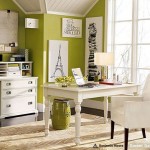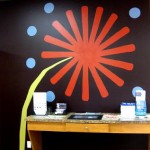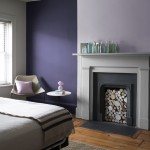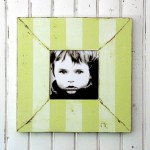 It’s been a while since we tossed up a “quick hitter” project–a project that should take you less than a couple hours and cost you less than $40–so I thought I’d pitch this one to you: painting an accent wall.
It’s been a while since we tossed up a “quick hitter” project–a project that should take you less than a couple hours and cost you less than $40–so I thought I’d pitch this one to you: painting an accent wall.
Painting an accent wall is an ideal project for the decorator on a budget. You can usually get by with less than a gallon of paint and the time it takes to paint one wall is, typically, about 1/4 of the time it takes to paint an entire room. (I’m throwing fractions around here just to show off my vast knowledge of math.)
Alright, with that said, let’s clarify what we’re talking about here. Painting an accent wall means taking a wall–the focal point of the room–and painting it a different (typically darker) color than the rest of the room. And that’s it. You don’t paint the other 3 walls, you don’t repaint your trim or your ceilings. You paint one wall a different color than the other 3 and you’re done.
Now, while that sounds easy, there are a couple things to think about when you tackle this project:
PICK THE RIGHT WALL
This is probably the biggest question folks deal with when they tackle this accent wall project: which wall do I choose? Typically, the answer you’ll get from paint people and do-it-yourself decorators alike is “paint the first wall you see when you walk into a room.”
Now, while that may not be always wrong, it’s certainly not always right. The correct answer is this: “paint the wall that your eye is naturally drawn to after you’ve entered a room.”
For example, if you walk into a bedroom, often times, as you approach the room, the first wall you see through the doorway is the side wall. Once you enter the room, your eye doesn’t linger there, though. Instead, your eye is naturally drawn to the wall that the bed stands against. That wall is the “focal” wall, the wall that you should consider for your accent wall.
So don’t spend so much time considering which wall you see first upon entering a room. Instead, spend more time looking around and noticing where your eyes are drawn. If you’ve got a fireplace in a living room, that wall is typically the focal wall. Painting an accent color against that wall will make your fireplace stand out, will draw attention in that direction and will give your room that “designer feel.” Other typical, natural focal points can be large paintings or a mirror, dominant pieces of furniture (a couch against a wall for example), or even an archway or a set of french doors. The walls that these items sit against, on, or in are candidates for the focal wall of the room.
PICK THE RIGHT COLOR
Once you’ve selected the right wall for your project, the next thing to consider (and, honestly, the last thing) is this: what color?
Often, when we hear the word “accent color” we think of orange. Or red. Or bright green. Or maybe a dark, dark blue. Basically, we think of bold, crazy colors. But don’t limit yourself in that regard.
Always remember that the depth or “boldness” of a color is subjective–it’s determined largely by the colors around it. If you’ve got a soft tan or an off white on all the walls of a room, even a mid-range blue or an earthy green would function as an “accent color”. In fact, an orange in a room like that would be really difficult (not impossible, but difficult) to pull off.
Conversely, if you have a room of medium to dark tones, you could go either direction. A bold orange, green, red, blue, brown could potentially be a tremendous accent color to put on that one focal wall. But, so also could an off white. If the rest of your room has some color and depth to it, even an off white can function as an accent color.
So, all that to say, don’t limit yourself (and scare yourself away from the project) by thinking that in order to do the project justice, you’ll need to pop open a can of “safety orange” and kiss your calm, peaceful room goodbye.
A great way to pick a color for an accent wall is to look to your fabrics–pull one of the colors out of the throw pillows on the couch or the comforter on the bed. Look to any art you have on the walls–is there a color in there that would look great on one single wall of the room–possibly the wall the picture itself is hanging on? What about the carpet? The window treatments?
Anyway, you get the idea. Find a wall, pick a color and spend a couple hours this weekend or next painting that one single wall and you’ll be amazed at the results!








 By Guest Writer, Shannon VandenBosch
By Guest Writer, Shannon VandenBosch
 It’s been a while since we tossed up a “quick hitter” project–a project that should take you less than a couple hours and cost you less than $40–so I thought I’d pitch this one to you: painting an accent wall.
It’s been a while since we tossed up a “quick hitter” project–a project that should take you less than a couple hours and cost you less than $40–so I thought I’d pitch this one to you: painting an accent wall.

 I found the picture frame at the left when I was cruising around the internet. It was pretty much the type of frame I needed for a particular project I had in mind.
I found the picture frame at the left when I was cruising around the internet. It was pretty much the type of frame I needed for a particular project I had in mind.

 hed, it’s time to create the handprint in the center. Now, this is not a difficult process, but there are a few things to know that will make your results turn out well. First, you’ve probably seen this done before (at school) where the handprint is “globby” and, well, for lack of a better word…ugly. The reason this happens is because kids usually mash their hands down on the paper while they’re covered with way, way, WAY too much paint.
hed, it’s time to create the handprint in the center. Now, this is not a difficult process, but there are a few things to know that will make your results turn out well. First, you’ve probably seen this done before (at school) where the handprint is “globby” and, well, for lack of a better word…ugly. The reason this happens is because kids usually mash their hands down on the paper while they’re covered with way, way, WAY too much paint.
 This week, I’ve been spotlighting some of the ArtPrize artists who RepcoLite was fortunate enough to work with during this year’s contest. Today, I want to show you some of the work done by Michael Mayosky.
This week, I’ve been spotlighting some of the ArtPrize artists who RepcoLite was fortunate enough to work with during this year’s contest. Today, I want to show you some of the work done by Michael Mayosky.
